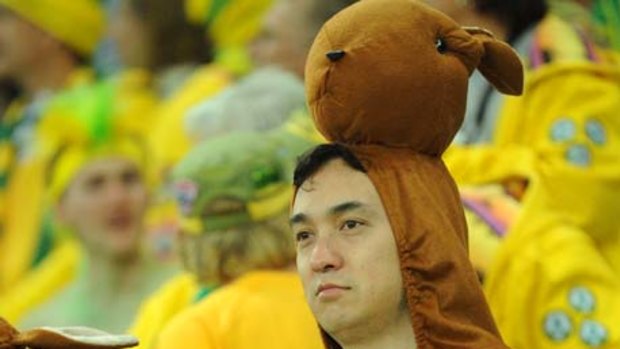By John Huxley
If some supporters had given up on the Socceroos, even gone home, it did not show in the famously zebra-striped stadium, where several thousand fans again turned up, waving green and gold banners, dancing with inflatable kangaroos, shouting themselves hoarse.
Just as they had for the previous game in Rustenburg, some 900 Fanatics, based in the tent city in Durban, rose at an unearthly hour - 3am, this time - for the 20-hour round trip by coach to Nelspruit.

Heading home ... An Australia fan watches on.Credit: Vince Caligiuri
"Morale's good," said organiser Warren Livingstone. "There's been no drop-outs. Everyone's travelling well."
(When will coach Pim Verbeek do something?)
Before the match the Fanatics "freshened up" at the Nelspruit botanical gardens, where a big screen had been erected for them to watch the earlier match between Slovenia and England, whom the Australians had dreamed of meeting in the round of 16.
Kevin Dixon, and girlfriend Rozanne Sheady, from Cessnock, had taken a more leisurely, two-day drive from Durban. How did they feel? "Awful," said Dixon. "But nothing a decent performance by the mighty Socceroos won't put right."
By midday, Fanatics, members of the Jo'burg-based Green and Gold Army and other independent supporters, who'd flown, driven and bussed their way halfway across South Africa to be at the game, were all over Nelspruit and surrounding towns like a Cote D'Ivoire central defender.
(When will Verbeek act?)
Buying imitation soccer strips in White River. Looking for hippos along the Crocodile River that runs through Nelspruit. Touring the motor museum in near-by Casterbridge, originally named by a farmer after the fictional town with the famous mayor in the Thomas Hardy novel.
Click here for for full match statistics
Match report: Australia 2 Serbia 1
Analysis: Brilliant Socceroos earn redemption
Brave Socceroos leave without the spoils
Ozil fires Germany into match-up with England
Before the game, there was a strong police presence in and around Nelspruit, not just to protect travelling fans from the ever-present threat of street violence, but to isolate troublemakers and prevent clashes between rival groups of supporters.
It may be some indication of the perceived sources of trouble that the Australian Federal Police had sent one officer to the north-eastern town, as part of its "mobile embassy" initiative for the World Cup, while the Serbian authorities sent four to assist the local force.
(Come on, Pim.)
On the eve of the match, described by some pundits as the most important ever played by the Socceroos - presumably since the last time - captain Lucas Neill urged Australians everywhere to tune in and see history in the making. "You will be surprised; someone will step up and be a hero."
It was a big ask. The Socceroos were playing their third game in 11 days. They had had one fewer days than did Serbia to recover. And, playing one man short after Harry Kewell's contentious sending-off, they had played their hearts out to secure a hard-earned 1-1 draw with Ghana.
Despite the tension, front-man Tim Cahill, who was returning from suspension, still found time to joke with one of the children who, holding hands, accompanied the players on to the field.
(At last, Pim acts. Australia scores. Australia scores again).
Throughout the game, media and supporters monitored progress in the other crucial Group D game, between Germany and Ghana, an all-white team dressed in black, an all-black team playing in white.
Four years ago, in Germany, Australia made a great start to their World Cup campaign, coming back from a one-goal deficit to put three late goals past Japan in their opening match. This time it was their misfortune to come up against a rampant German team in their first match.
(Oh, no, Serbia score)
The end was tumultuous, with enough effort and excitement coming from the Socceroos to have their fans standing and cheering at the end. But it was all too late. The truth was, the Socceroos were never going to recover from that 4-0 thrashing by Germany at the start of their campaign.
(Goodbye, Pim.)